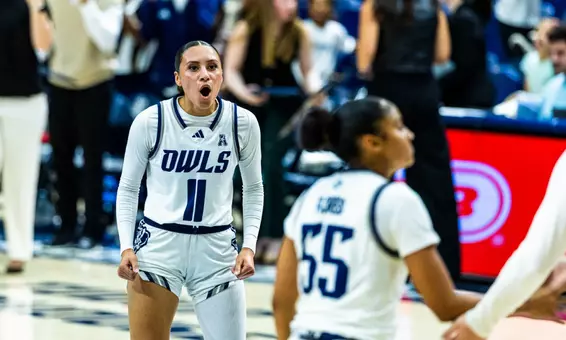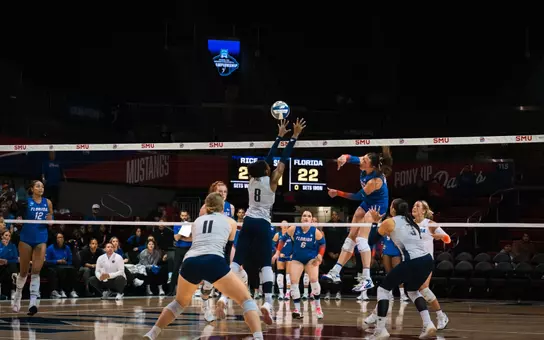
Five Sports Post Perfect Scores in NCAA Graduation Success Report
12/8/2023 1:29:00 PM | Baseball, General, Women's Basketball, Women's Soccer, Women's Tennis, Women's Volleyball
Baseball, women's basketball, soccer, women's tennis, and volleyball
Student-athletes across the country are graduating at record rates according to the latest data released by the NCAA on Wednesday and Rice Athletics continues to be at the forefront of that success. Figures released Wednesday reflect graduation numbers among student-athletes who entered college in 2016.
Rice women student-athletes ranked seventh in the nation in the Federal Graduation Rate among schools at the FBS level, graduating 90% of its participants. Rice also posted the fourth-highest federal rate among African-American students (81%) for the fourth consecutive year while its entire student-athlete population ranked seventh (81%). Rice football ranked second among FBS football programs with a Fed Rate of 88%.
Baseball, women's basketball, soccer, women's tennis, and volleyball each graduated all of their student-athletes in the NCAA's GSR tabulations, which reflect the six-year graduation rates for college athletes who entered school in 2016.
The Federal Graduation Rate remains the only measure comparing student-athletes with the general student body. Rice's student-athletes tied for seventh nationally in the latest data (with Illinois, Michigan, Stanford and Virginia), while the student body ranked seventh in a four-way tie with California, Michigan, and Vanderbilt.
Federal rates also provide a long-term picture of student-athlete academic achievement. The federal rate was first collected with the class that entered college in 1984, and the rate has continued to rise over the past 30 years. When rates were first collected, the general student body earned degrees at a rate higher than that of student-athletes.
The Division I Board of Directors created the GSR in 2002 in response to Division I college and university presidents who wanted data that more accurately reflected the mobility of college students than the federal graduation rate did. The federal rate counts as an academic failure for any student who leaves a school, no matter whether he or she enrolls at another school. Also, the federal rate does not recognize students who enter school as transfer students.
The GSR formula removes from the rate student-athletes who leave school while academically eligible and includes student-athletes who transfer to a school after initially enrolling elsewhere. This calculation provides a more accurate look at student-athlete success.
Rice women student-athletes ranked seventh in the nation in the Federal Graduation Rate among schools at the FBS level, graduating 90% of its participants. Rice also posted the fourth-highest federal rate among African-American students (81%) for the fourth consecutive year while its entire student-athlete population ranked seventh (81%). Rice football ranked second among FBS football programs with a Fed Rate of 88%.
Baseball, women's basketball, soccer, women's tennis, and volleyball each graduated all of their student-athletes in the NCAA's GSR tabulations, which reflect the six-year graduation rates for college athletes who entered school in 2016.
The Federal Graduation Rate remains the only measure comparing student-athletes with the general student body. Rice's student-athletes tied for seventh nationally in the latest data (with Illinois, Michigan, Stanford and Virginia), while the student body ranked seventh in a four-way tie with California, Michigan, and Vanderbilt.
Federal rates also provide a long-term picture of student-athlete academic achievement. The federal rate was first collected with the class that entered college in 1984, and the rate has continued to rise over the past 30 years. When rates were first collected, the general student body earned degrees at a rate higher than that of student-athletes.
The Division I Board of Directors created the GSR in 2002 in response to Division I college and university presidents who wanted data that more accurately reflected the mobility of college students than the federal graduation rate did. The federal rate counts as an academic failure for any student who leaves a school, no matter whether he or she enrolls at another school. Also, the federal rate does not recognize students who enter school as transfer students.
The GSR formula removes from the rate student-athletes who leave school while academically eligible and includes student-athletes who transfer to a school after initially enrolling elsewhere. This calculation provides a more accurate look at student-athlete success.
WBB: Rice vs. Marshall Postgame Presser
Wednesday, March 09
VB: Rice-Texas Postgame Presser
Saturday, December 04
VB: Rice-San Diego Postgame Presser
Thursday, December 02





